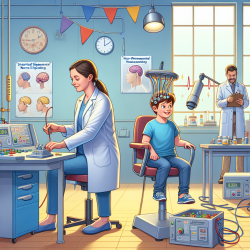Introduction
Attention-Deficit/Hyperactivity Disorder (ADHD) is a prevalent neurodevelopmental disorder affecting approximately 5-7% of children globally. Traditionally, stimulant medications have been the primary treatment for ADHD, but they come with side effects and compliance issues, particularly in adolescents. As a result, there is a growing interest in non-pharmacological treatments, such as External Trigeminal Nerve Stimulation (eTNS), which has been approved by the FDA for ADHD treatment since 2019.
The Study
A recent study titled "The efficacy of real versus sham external Trigeminal Nerve Stimulation (eTNS) in youth with ADHD over 4 weeks: a protocol for a multi-centre, double-blind, randomized, parallel-group, phase IIb study (ATTENS)" explores the efficacy of eTNS in treating ADHD. This study involved 150 youth participants across London, Portsmouth, and Southampton, UK, who were randomized to receive either real or sham eTNS for four weeks.
Key Findings
The primary outcome of the study was the change in ADHD symptoms as rated by parents using the ADHD rating scale. Secondary outcomes included cognitive measures, objective hyperactivity, and side effects. The study also explored the mechanisms of action using MRI in a subgroup of participants.
- Symptom Improvement: The study found significant improvements in ADHD symptoms with real eTNS compared to sham treatment, with minimal side effects.
- Cognitive Benefits: Participants showed improvements in executive functions, such as attention and working memory.
- Long-term Effects: The study aims to assess the persistency of effects over six months, providing insights into the long-term benefits of eTNS.
Implications for Practitioners
For practitioners, these findings highlight eTNS as a promising non-drug treatment option for ADHD, especially for patients who experience side effects from medications or have compliance issues. Implementing eTNS in clinical practice could provide a valuable alternative, improving outcomes for children with ADHD.
Encouraging Further Research
While the study provides robust evidence for the efficacy of eTNS, further research is needed to understand the underlying mechanisms and to confirm its effectiveness in broader populations, including adolescents. Practitioners are encouraged to engage with ongoing research and consider participating in future studies to expand the evidence base for eTNS.
Conclusion
The study on eTNS presents a compelling case for its use as a non-pharmacological treatment for ADHD, offering a safer alternative with fewer side effects. As we continue to seek better outcomes for children with ADHD, embracing innovative treatments like eTNS is crucial.
To read the original research paper, please follow this link: The efficacy of real versus sham external Trigeminal Nerve Stimulation (eTNS) in youth with Attention-Deficit/Hyperactivity Disorder (ADHD) over 4 weeks: a protocol for a multi-centre, double-blind, randomized, parallel-group, phase IIb study (ATTENS).










